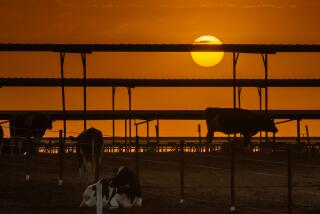Weather Snags Planting of Cotton in State
- Share via
Battered by wind, rain and temperatures nearly 20 degrees below normal this spring, California’s cotton--the state’s largest crop and perennial leading export--has gotten off to what some farmers say is the worst start in half a century.
Thousands of damaged cotton acres in the San Joaquin Valley are being replanted, but time is running out on growers scrambling to get a healthy crop started in time for the prized, long-staple cotton to mature before the fall rains, said Tom W. Smith, president of Calcot Ltd., a Bakersfield-based cotton-marketing cooperative. At the same time, he said, growers reported that the heavy winds and continued cold weather that ushered in May held back germination and growth of some of the new plantings.
The upshot, Smith said, is likely to be reduced production per acre that will translate into less income and higher production costs for growers. The region’s smaller crop will not necessarily translate into higher prices, however, because the commodity trades on a world market fed by Texas and the southeastern United States and a number of foreign nations.
California’s cotton farmers enjoyed a brief recovery in 1987 after having sustained a devastating string of bad years because of falling export sales and increased foreign production. But larger-than-expected crops from China and Pakistan hit the market last August, Smith said, and prices have been in a tailspin since.
The so-called adjusted world price fell from a high of 76 cents a pound then to less than 53 cents last week, according to Calcot. While San Joaquin Valley Acala cotton commands a premium for its superior brilliance and yarn-making ability, the premium tends to rise and fall with cotton prices generally.
To meet the demand of San Joaquin Valley growers for additional seed supplies, the delinting facility at McFarland, which furnishes nearly one-third of the valley’s planting seed, has been operating 24 hours a day, up from 12 hours. While certain varieties of seed are in short supply, alternatives remain readily available.
More to Read
Inside the business of entertainment
The Wide Shot brings you news, analysis and insights on everything from streaming wars to production — and what it all means for the future.
You may occasionally receive promotional content from the Los Angeles Times.










